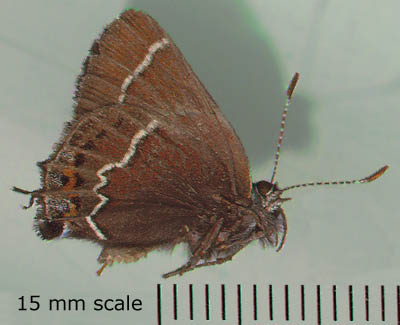BUG OF THE MONTH: December 1996
The 'Mistletoe Hairstreak' Butterfly
Mitoura johnsoni (a.k.a. Johnson's Hairstreak)
Order Lepidoptera, Family Lycaenidae
Copyright © 1996 by Tatoosh Taktoe
This article originally appeared in Scarabogram, December 1996, New Series No. 200, pp. 2-3.
Ho, ho, ho. How fitting that our bug this December is the rare and elusive mistletoe hairstreak, so named because the larvae feed on dwarf mistletoe, Arceuthobium spp. Now there are several species of dwarf mistletoe. All are parasites on conifers: western hemlock, Douglas-fir, true firs, pines, as well as larch and even Engelmann spruce.

So let's let this sink in. Our hairstreak feeds on a plant that is a parasite on another plant. You might be piecing together just why this hairstreak is rare. After all, parasites harm their hosts. If your food is something that harms its host, like if you eat Dutch elm beetles, you're bound to have tough going from time to time.
Now before I get you all confused, I'll just 'fess up that dwarf mistletoe is not the same mistletoe that's sold in little packages for Christmas amour. The Christmas kind is just plain mistletoe, a separate genus, Phoradendron. It has bigger, somewhat fleshy leaves, whereas the dwarf mistletoe looks a bit like a set of pipe cleaners gone awry.
In our area, mistletoe hairstreaks tend to be found in mature coniferous forests infested with dwarf mistletoe. Mistletoes (plural? Dan Quayle, help me!) are not really abundant, but common enough to have won a place in the Pacific Northwest Plant Disease Handbook (Koepsell & Pscheidt 1994). Since at lower elevations, mature coniferous forests harbor very tall trees, mistletoes and the hairstreaks that frequent them tend not to be too noticeable to hikers and other passers-by. Although hairstreaks fly high in the trees, mid May through July (Christiansen 1981), they descend occasionally to take nectar. Even then, nectar plants given by Pyle include dogwood, so they don't always come down very far. Keep looking up! Other nectar plants are listed as Oregon grape, pussy paws and in dryer forests, ceanothus (Pyle 1981).
The adults are a tasteful brown: reddish brown in females, chocolate brown in males. The underside is also a sleek dark brown in both sexes, punctuated by a thin white post-medial line through both fore and hind wing, breaking the silhouette, enhancing the slenderness of this already dainty butterfly. The hind wing also has the namesake hair-like tails, with black dots and orange and bluish scales accentuating the area near the tails. As with most hairstreaks, the antennae are ringed with white, reminiscent of a French chorus girl's stockings. An elegant, whimsical but cryptic color scheme. (Data from Pyle 1981, flair by Ralph Lauren).
The caterpillars have inherited this basic good taste, and are a versatile dark green. But they have an added splash of fun: carefree diagonal markings of white, yellow and red. Since dwarf mistletoe is yellowish to green, who knows? Maybe these colors really are cryptic too.
Let us bid adieu to our fair hairstreak, harbinger of the holidays, and get on with other merriment. I wish for you all a Christmas season filled with fun, and a new year "compleat" with a sighting of this rare and tasteful butterfly.
References
Christensen, James R. 1981. A Field Guide to the Butterflies of the Pacific Northwest. University of Idaho Press, Moscow, Idaho.
Koepsell, Paul A., and Jay W. Pscheidt (editors). 1994. Pacific Northwest Plant Disease Control Handbook. WSU Cooperative Extension, Pullman, Washington.
Pyle, Robert Michael. 1981. The Audubon Society Field Guide to North American Butterflies. Alfred A. Knopf, New York.
This page last updated 26 July, 2005